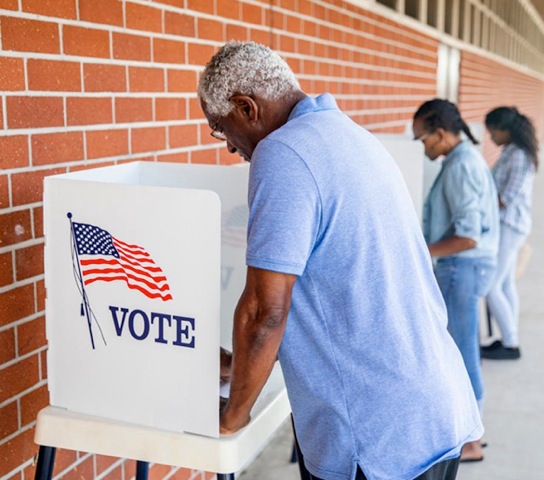THE HUTCHINSON REPORT
By Earl Ofari Hutchinson
Contributing Columnist
The Republican Party’s relentless war on alleged rampant voter fraud targets not thousands, as many critics have noted, but millions of eligible voters.
The Brennan Center for Justice found that the majority of the five million eligible voters that could be banned from the polls under the new restrictive laws rammed into place in a dozen states by Republican governors and GOP-controlled state legislatures were Black, Latino or American Indian, low income and young voters.
The U.S. Supreme Court decision upholding the Arizona voter restrictions, the Georgia and Texas tough new restrictions and the vote suppression measures proposed in two dozen more Republican-controlled legislatures will add even more millions who can be dumped from the voting booth.
In 2008, those voters provided the decisive margin for President Barack Obama’s White House victory in Ohio, Pennsylvania, North Carolina, Florida, Virginia and Colorado. In 2000 and 2004, President George W. Bush won five of those six states.
In every case, he needed a solid turnout from older, white, conservative, overwhelmingly male voters to win.
That changed radically in 2008 with Obama’s win. Republican strategists were determined that there would be no repeat of this in 2012 and unleashed their voter suppression campaign. Attorney General Eric Holder counter-attacked with Justice Department lawsuits, court actions and injunctions to try to halt the GOP effort to suppress the vote.
Holder’s tactics against the Republicans’ ham-fisted efforts to shoo as many poor, minority and young voters away from the polls in November and beyond almost certainly is a major reason for the GOP’s furious political mauling of him.
GOP-controlled House committees launched investigation after investigation into Holder for everything from alleged perjury to malfeasance of office during his Justice Department tenure.
For the GOP, its voter suppression smokescreen was about numbers; two numbers to be exact. One number is the popular vote. Democratic presidential candidate Al Gore got a bigger share of the popular vote than Bush in 2000. He got that because of the heavy turnout in key states of the GOP’s prime vote suppression targets, blacks, Latinos, and the young voters.
In a super tight 2012 race, the five million voters that the Brennan Center documented as potential victims of the GOP’s disenfranchising rash of voter ID and registration laws, could have tipped the popular vote to Republican candidate Mitt Romney.
The five million vote estimate turned out to be an undercount since some estimates put the number at more than 20 million possible eligible voters that potentially are affected by the torrent of GOP-driven requirements.
Gore’s popular vote win in the presidential contest in 2000 showed a popular vote majority is meaningless without securing the 270 electoral votes needed to win the presidency. This is the second number the GOP’s voter suppression campaign aims to attain.
The states that have clamped on the new voter restrictions would consistently provide 171 electoral votes in presidential elections.
That’s more than 60% of the total needed for a presidential candidate to win the White House. The one crucial state that Obama did wrest from the GOP in 2008 and 2012, Pennsylvania, has been a special target of the GOP’s suppression war.
If the state’s new stricter, voter ID law had been in place in both years, the margin of Obama’s victory in the state would have been much smaller, if at all.
In 2016, the vote suppression campaign bore fruit for President Donald Trump, who won both the popular vote and the state’s electoral votes. He won because of a marked downtown in the Black and Hispanic votes in the state’s urban areas.
The GOP claims that its only concern is to ensure clean and fair elections, nabbing vote fraud lawbreakers and upholding constitutional precepts of rampant voter fraud. These are phony, self-serving fraudulent excuses.
Studies that examined alleged voter fraud in Ohio and Wisconsin in the 2002 and 2004 elections found only a handful of actual cases of voter fraud. More than nine million votes were cast in the two states in both elections. That as has been shown was the same in the 2016 and 2020 presidential elections.
Holder made his most dogged challenge to the GOP voter suppression campaign in Texas, which had enacted a rigid voter ID law. He bluntly called it a new poll tax, which is the racist weapon Southern states used for decades to keep Blacks from the polls. It took decades of protests, marches, litigation and a Supreme Court decision to finally dump the poll tax.
The GOP banks that its new voter suppression tactics will hold up for years and through many elections to come, starting with the 2022 congressional elections and the big prize, the White House in 2024. The GOP is dead set that there will be no repeat of 2020 in the coming national elections.
Earl Ofari Hutchinson is a political analyst and writer. This is the last in a four-part series on the Republican Party’s war on voting rights and part of a forthcoming book, “Bring Back the Poll Tax! -The GOP’s War on Voting Rights” (Middle Passage Press). The book will be officially released Aug. 6, the 56th anniversary of President Lyndon Johnson’s signing of the 1965 Voting Rights Act.












